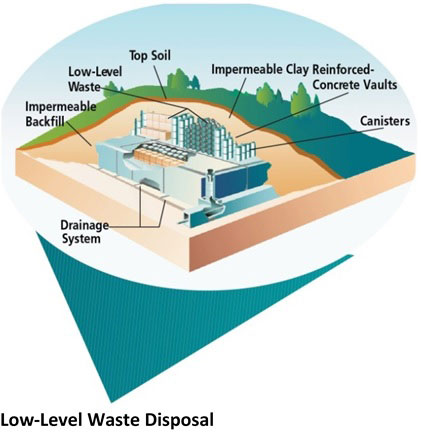Backgrounder on Blending of Low-Level Radioactive Waste
On this page:
In 2008, hospitals, universities and reactors in 36 states began storing most of their low-level radioactive waste (LLW) when they lost access to the only disposal facility that could receive it. Nuclear utilities started to look at blending as an alternative to storing their waste. Their interest prompted the NRC to strengthen the guidance for LLW blending. The goal waste to make that guidance more consistent with the agency’s overall policy for regulating the nuclear industry.
Blending higher activity and lower activity waste can lower the concentration of radioactivity. The mixture would then be suitable for disposal at more locations and at lower cost. Today, an additional disposal site is available and a waste processing facility in Erwin, Tenn., owned by EnergySolutions and licensed by the state, offers blending.
Classification and Disposal

LLW is classified at the time of disposal according to its radioactivity. Most LLW (about 95 percent) has the lowest concentration and is Class A. (Concentration is the amount of radioactivity divided by the weight or volume of the waste.) Class B and Class C wastes have higher concentrations. As waste class increases, additional measures to control the hazard to the public are required. For example, because of its higher hazard, Class C waste must be buried deeper or with a special barrier designed to last at least 500 years.
There are four facilities licensed to dispose of low-level radioactive waste:
- EnergySolutions' site in Barnwell, S.C., accepts A, B and C wastes from South Carolina, New Jersey and Connecticut
- U.S. Ecology’s site in Richland, Wash., accepts A, B and C wastes from 11 states in the Northwest and Rocky Mountain regions
- EnergySolutions' site in Clive, Utah, takes only Class A waste and is open to the entire country
- Waste Control Specialists’ site in Andrews, Texas, opened in 2012 and can take A, B and C from across the country
Blending of LLW means mixing wastes of different concentrations to create a product with more uniform radionuclide concentrations. It does not mean mixing LLW with non-radioactive waste, a practice known as "dilution." And it does not imply release of radiation to the general environment, either in municipal landfills or in consumer products. Because of the need for a relatively homogeneous mixture, blending would primarily involve resins used to clean contaminated water at commercial nuclear power plants. The NRC issued an environmental evaluation in 2013 of six different methods for handling resins from nuclear power plants, after taking public comments on a 2012 draft. The report found that any environmental impacts from disposal of blended wastes would be small.
Revised Guidance
NRC regulations do not prohibit blending to lower the waste classification. NRC guidance, issued in 1995, placed certain constraints on LLW blending that were not fully risk-informed, meaning the burden of meeting the requirements is appropriate to their importance in protecting public health and safety. Nor were they performance-based, because they were not tied to a measurable outcome such as meeting radiation limits at the disposal facility. The NRC revised the guidance to better conform to the Commission’s policy of making its regulations more risk-informed and performance-based.
The revised guidance, published in February 2015 as a draft for public comment, addressed concentration averaging for a variety of wastes, including blended waste. In March 2015, the staff published a proposed rule to address disposal of blended waste and other unanalyzed waste streams. During this rulemaking process, the Commission directed the staff to make substantive revisions and republish the rule.
In May 2024, the staff provided to the Commission a new proposed rule, titled “Integrated Low-Level Radioactive Waste Disposal.” The 2015 draft guidance is being revised to conform with the new proposed rule. Upon direction by the Commission, the proposed rule and revised guidance will be published for public comment.
June 2024
Page Last Reviewed/Updated Monday, December 01, 2025
Page Last Reviewed/Updated Monday, December 01, 2025

